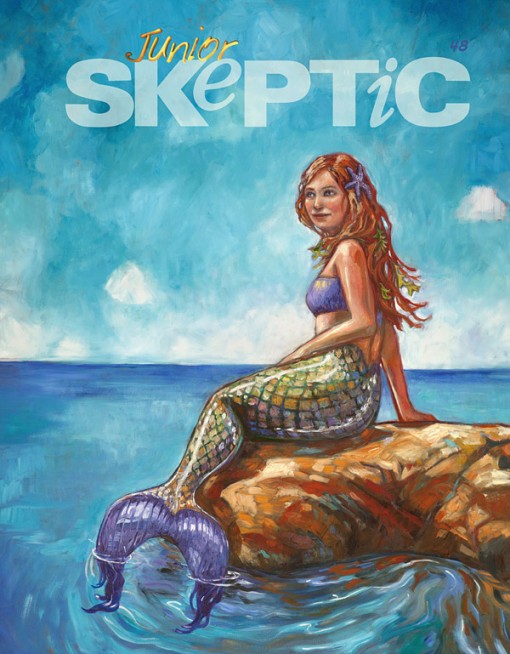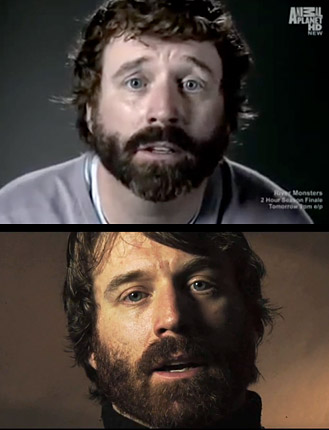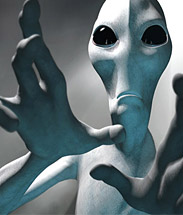This look back at Discovery’s 2012 and 2013 mermaids hoaxes is an excerpt from Junior Skeptic 48 (published in 2013 inside Skeptic magazine Vol. 18, No. 3). The damage done to English-language television’s premier nonfiction brand by these and subsequent misleading ratings stunts (including what I described as “the profound awfulness” of 2014’s Russian Yeti: The Killer Lives) has been widely discussed by critics. As I reflected last year, “At this point, Discovery could announce that they’d made a sandwich during Monster Week and I’d wonder if that were true.”
As the network attempts to regain its dignity, this seemed an opportune moment to review how they put themselves in this compromised position.
Junior Skeptic is written for (older) children and does not include endnotes, though I often call out important sources in sidebars or the text of the story itself. However, I’ve included some links and relevant citations here for your interest.

Junior Skeptic 48 cover. Painting by Corinne Garlick. Oil on board.
Monster hunters have remained interested in mermaid-like creatures such as the Ri [a cryptozoological mystery from Papua New Guinea—see Junior Skeptic 48], and mermaid sightings are still sometimes reported in countries in Africa and elsewhere around the world. But people in the United States and other industrialized countries generally think of mermaids as completely imaginary fantasy creatures like dragons, gremlins, or leprechauns.
Or at least, they did. Then, in 2012, the Animal Planet television channel aired a documentary-style program called Mermaids: The Body Found. [Watch trailer.] Three and a half million viewers watched in astonishment as people identified as U.S. government scientists from the National Oceanic and Atmospheric Administration (NOAA) looked straight into the camera and told the public about incredible evidence for the existence of mermaids. Not only are mermaids real, claimed the program, but they are an evolutionary offshoot of the human family tree!
Could that be right? It certainly seemed like it. The on-screen scientists said they found the gruesome remains of a mer-person inside the stomach of a large shark. There was even a camera-phone video of a living mermaid stranded on an American beach! From the deep-voiced narrator to the compelling personal testimony, the show hammered home the unbelievable message that mermaids exist after all.
Hoax, Entertainment, or Both?
In particular, the sincerity radiating from NOAA scientist Dr. Paul Robertson seemed impossible to ignore. But there was a big problem: “Dr. Paul Robertson” was not a scientist at all. He wasn’t even a real person, but an invented television character. The entire program was fake!
Mermaids: The Body Found looked and felt like a documentary, but it was actually a work of make-believe. The “evidence” for mermaids that was presented in the show was invented by script-writers and special effects artists. On-screen text at the beginning of the show told audiences, “The scientists in this film are speaking on camera for the first time,” but those “scientists” were really actors.
The mermaids special was so convincing that many people who saw the show were fooled into thinking mermaids were real. This was upsetting to some science writers and marine biologists. After all, Animal Planet is supposed to be a channel where people learn about real animals. Few viewers expect Animal Planet to mislead them with fake facts.
But mislead, it did. “The show was meant to titillate and deceive” raged science writer Brian Switek. He called the mermaids special “another bit of noxious rot in…television’s bottomless chum bucket.” A brief, vague disclaimer at the end of the credits admitted “certain events in this film are fictional,” but as Switek argued, “it’s not surprising that some viewers were confused about what they were actually seeing.”1 If you dress up a science fiction program to look exactly like a documentary and then play it on a documentary channel, what else can you expect but confusion?
The confusion created by the show was clearly not surprising to Animal Planet nor the Discovery Channel, which later re-broadcast the special. (Both channels are owned by the same company.) Promotional material admitted the show was “science fiction,” but also boasted, “Mermaids: The Body Found paints a wildly convincing picture of the existence of mermaids, what they may look like and why they’ve stayed hidden…until now.”
When a CNN television reporter directly asked the show’s creator, “Did people think this was real? When the 3.5 million people watched this on Sunday night? … How many of those are, like, wow, mermaids are real?”2
“I think a fair number of them think that it’s possible,” answered the filmmaker. He didn’t seem upset that people were fooled. Instead, he said he was “very flattered” because the artists who made the show worked so hard “to create a world that was very convincing.”
Indeed, it was so convincing, reported CNN, that the National Oceanic and Atmospheric Administration had to issue a statement: “Neither NOAA nor its scientists are involved with anything related to this topic. No one from NOAA was involved in making the fictional show and the person identified as a NOAA scientist was an actor.” Other scientists objected to the film’s promotion of a real but debunked old scientific idea: the “aquatic ape” hypothesis. This was the mistaken suggestion that our prehistoric ancestors could have lost our shaggy pelts of body hair as an adaption to help them spend much of their time wading in shallow water at the sea shore. Scientific evidence does not support this idea at all, but the filmmakers used it as a justification for imagining the evolution of their science fiction mermaids—and argued in the press that this “aquatic ape” business might be true after all. And the filmmakers weren’t done yet.
The Sequel
In 2013, Animal Planet aired a sequel called Mermaids: The New Evidence. It was even more realistic and persuasive than the original. The sequel featured the return of fictional NOAA scientist Paul Robertson, again played by Dave Evans. This time, the fictional scientist sat down for a one-on-one news-style interview with a real television news presenter, who played himself. The show artfully blended together real film footage and fake, real people and actors, until it was impossible to know what was real and what was pretend. Discussing some of the fake video footage, the host solemnly asked, “how can we tell the faux from the real? I’m with Dr. Paul Robertson, the central figure in the documentary Mermaids: The Body Found that exposed the mermaid conspiracy.” But the joke was on the audience, for there is no “Dr. Paul Robertson” and no mermaid conspiracy—and Mermaids: The Body Found was not a documentary.
Why Would Anyone Do That?
It’s easy to understand why TV producers would be willing to promote hoaxes. Television networks make their money from showing commercials and attracting cable subscribers. As far as the business of television is concerned, it doesn’t matter if viewers learn something or get fooled—it just matters that they watch. And watch, they did.
After the sequel aired, Animal Planet sent out a triumphant press release. “Animal Planet’s Mermaids: The New Evidence catches 3.6 million viewers,” making it “the network’s #1 most-watched telecast of all time,” boasted the network. Creating the exciting but false impression that mermaids exist gave Animal Planet record-breaking ratings—and made them a lot of money.
Meet the Real “Dr. Robertson”

Dave Evans in his 2012 role as “Dr. Paul Robertson” in Mermaids: The Body Found (above) and his 2008 role as “Dr. Mark Hoyt” in The Goblin Man of Norway (below).
Much of the persuasiveness of the two mermaids specials comes from the likable, believable performance of the man who played Dr. Robertson. His real name is Dave Evans. He works as a Creative Director in the video game industry in Canada. I contacted Dave to learn more.
Although acting is not his main job, Mermaids: The Body Found was not the first time he played a fake scientist. He was “discovered” and cast in the first mermaids show after playing a very similar role as “Dr. Mark Hoyt”3 in an online video he helped to produce called The Goblin Man of Norway. [Watch video.] This was another fake but well-crafted documentary about an astonishing (pretend) scientific discovery: not mermaids that time, but an ancient mechanical humanoid frozen inside a glacier. The Goblin Man of Norway was created as a fun way to promote an Xbox 360 video game called Too Human.
Dave Evans loves science—his father was a chemistry teacher—but he also loves science fiction. “I very much enjoyed working on the mermaids project,” he told me. He does not “consider mermaids a threat to scientific understanding.”4 Instead, he liked that the shows argued that powerful Navy sonar systems can harm whales (a plausible danger that has been debated all the way to the U.S. Supreme Court). “I think as pieces of fiction,” Evans said, “the Mermaids specials were both entertaining and thought provoking, and I will leave it to the producers of Animal Planet to defend the amount of disclosure provided regarding the fictional nature of the piece.”5 (Actors don’t make the decisions about how to market TV shows.)
Although he’d love to see a sequel that clearly explained what was fact and what was fiction, he feels viewers have some responsibility to be cautious about what we see on TV or read on the Internet. He recommends Snopes.com, which has a page debunking the mermaids specials.
I enjoyed the shows myself—as science fiction. But I’m reminded of an 1824 London Times review of the very same fake mermaid that P.T. Barnum would later exhibit: if it had been shown as a work of art, said the paper, it “would have been praiseworthy.”6 Instead, it was used to fool people. Animal Planet tried to walk the line between art and hoax. But if we can’t see the line—or if the line is hidden from us on purpose—isn’t that just a trick?
References
- Brian Switek. “Mermaids Embodies the Rotting Carcass of Science TV.” Wired.com, May 31, 2012. http://www.wired.com/wiredscience/2012/05/mermaids-embodies-the-rotting-carcass-of-science-tv/ (Accessed June 8, 2015)
- Transcript, Starting Point with Soledad O’Brien. “Obama Administration Attacks Romney’s Time as Massachusetts Governor; Interview with Deval Patrick; New Tapes Released Concerning Charles Manson; Two American Kidnapped in Egypt; Truancy Case Controversy; Banning Big Sugary Drinks; Are Mermaids Real?” Aired May 31, 2012 06:59 ET. http://transcripts.cnn.com/TRANSCRIPTS/1205/31/sp.01.html (Accessed June 8, 2015)
- “Dr. Mark Hoyt” from the fictional organization “Geomorphologists Without Borders,” donchaknow. (Watch video.)
- Dave Evans. Email to Daniel Loxton. August 5, 2013
- Dave Evans. Email to Daniel Loxton. August 2, 2013
- “The Merman.” The Times of London. June 26, 1824. p.6


 Ten-page illustrated Junior Skeptic stories are bound within each quarterly issue of SKEPTIC MAGAZINE.
Ten-page illustrated Junior Skeptic stories are bound within each quarterly issue of SKEPTIC MAGAZINE. 










The History Channel, Discovery Channel, Animal Planet: another one bites the dust (to paraphrase the great Freddie Mercury). However, we should all be happy that these “educational” programming broadcasters are forced to have fake scientists present quasi-scientific processes when pulling these ruses. This indicates to me that the “dumb” masses prefer to listen to scientists when it comes to science stuff. Just think, not even a hundred years ago the organized religious establishment were the only “experts” people would take seriously. I call this progress. However, when the Military Channel and Science Channel start pulling this crap, I’M OUT.
As a Brit, I find the level of gullibility of certain sections of the US population both intensely amusing and, perhaps more importantly, very alarming. Daniel Loxton is probably right to be concerned over sci-fi masquerading as fact/documentary but surely such programmes and their audience figures do perhaps give an insight over time about how successful the SS and skeptics in general are succeeding in educating the masses in critical thinking. Probably the most dispiriting information in the article was that viewing figures actually increased slightly for the sequel to the original programme.
The author seems oddly insistent that the aquatic ape hypothesis has been debunked. There’s not a lot of direct evidence supporting it, but I’m unaware of any convincing debunking either. Usually, there’s just a lot of harumphing whenever someone brings it up.
Which is odd, because in its weak form, the hypothesis is undeniably true. We did, at some point, develop an affinity for the water which our closest relatives do not have. Whether this is responsible for any of the major adaptations that we like to think define us as human (hairlessness, bipedalism, big brains) is another matter.
Still, the aquatic explanation for human bipedalism remains by far the most compelling explanation I’ve heard.
I turned on the Discovery channel several times a couple weeks ago, and each time it was showing either some reality show about bearded rednecks or Naked and Afraid.